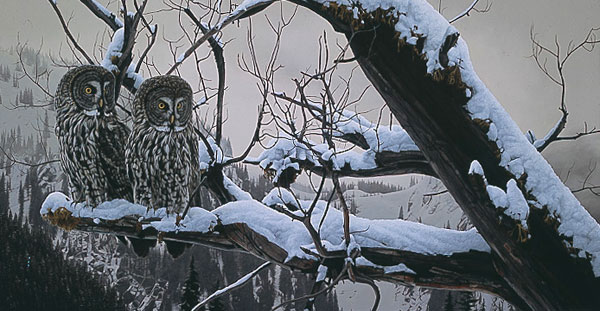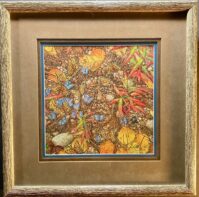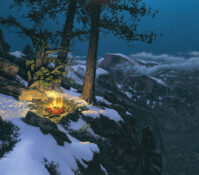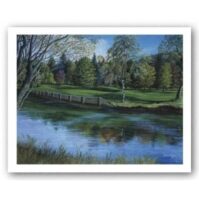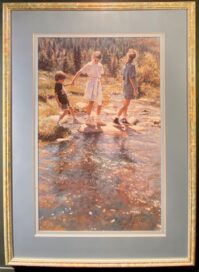Shadows of Dusk by Rod Frederick-Consignment
$175.00
2 in stock
Description
SHADOWS OF DUSK by Rod Frederick Limited Edition of: 1500, Image Size: 28 1/2″w x 15″h. Published: July 1993
The great gray owl is a rare northern owl who hunts the dense evergreen forest of southern Canada and the northern United States. With a wing-span of fifty-four to sixty inches and a height of twenty-four to thirty inches, the great gray is the largest North American owl in size, although not in weight.Great grays are distinguished by their yellow eyes, puffy head and the concentric circles of its facial disks. Like other northern owls, such as the snowy and short-eared, great grays do some daytime hunting. Their silent flight makes them wraithlike even in daylight. They prey on mice, voles, chipmunks and other small mammals.
Man has killed so many of these great grays that they have become scarce. Today they are protected along with other birds of prey and their numbers are increasing. Still, it is rare, and always exciting, to spot even one of them. This pair was in the Cascade Mountains, hunting in a forest of ponderosa pine and juniper.
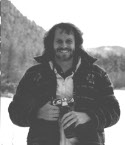 |
Rod Frederick has grown up with animals…. from a menagerie of pets that populated his boyhood home, to a combination biology and fine arts degree in college. Born in Salem, Oregon, Rod Frederick grew up in Portland. Artistic influences shaped Rod Frederick’s boyhood – his mother had a degree in fine art, and his father, a lawyer, spent weekends at the easel. The Frederick household was always full of various animals, so it was entirely natural for Rod to combine his interests in art and animals into a career as a wildlife artist.
Rod Frederick attended Willamette University, majoring in art and minoring in biology. Standing six feet, four inches, Rod Frederick also found time to play forward for the university’s basketball team. After completing his schooling, Rod Frederick accepted a variety of commissions that led him to paint classic scenes of the Northwest. Barns, covered bridges, mountains, fields and ponds became the focal point of Rod Frederick’s art, but gradually he worked more and more wildlife into his paintings.
Today Rod Frederick’s career is wildlife art. And Rod Frederick still has a house full of pets. Only Rod Frederick now goes beyond the domesticated variety to seek out wildlife in its natural environment: in the mountains, high above the timberline; in the forest that cover the Northwest; in streams and ponds where wildlife of all forms congregate.
Rod Frederick’s curiosity about animals and his own dedication to realism dictate the way he works: devouring every source of reading material about a particular species; photographing and sketching; and devoting large amounts of time to research in the field. Rod Frederick finds his favorite environment in the mountains, above the timberline, because “the open spaces are exciting. I have a chance to ‘get away’ and perhaps get a glimpse of my favorite animal, the mountain goat.”
“People tell me they like the natural colors and mood I create in my work,” Rod Frederick says. “They say it’s very realistic, and that’s what I’m looking for.”
Rod Frederick lives in Oregon, where he has an inspirational view of the Cascade Mountains right outside his window. Rod Frederick uses oils and gouache to paint his wilderness scenes. Rod Frederick is featured in the book: The Best of Wildlife Painting (North Light Books, 1997).
Rod Frederick is always ready to travel in search of new subjects. “Often,“ Rod Frederick says, “I’ll look for a particular species, and what I’ll see is something totally unexpected. The unpredictability of seeing animals in the wild is exciting – it’s what I call “planned unpredictability.” When you do see what you’ve planned to see it’s serendipitous.”
